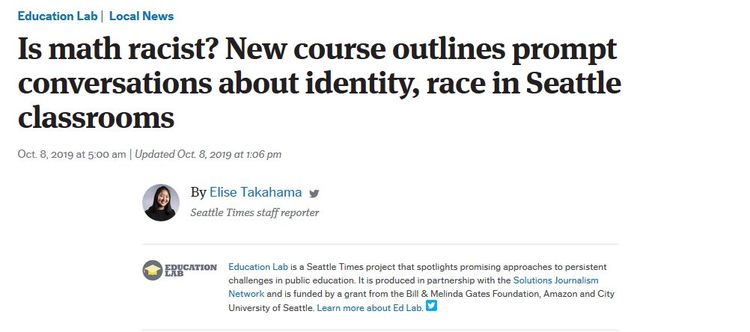From the Seattle Times news section:
Is math racist? New course outlines prompt conversations about identity, race in Seattle classrooms
Oct. 8, 2019 at 5:00 am
By Elise Takahama
Seattle Times staff reporter
Education Lab is a Seattle Times project that spotlights promising approaches to persistent challenges in public education. It is produced in partnership with the Solutions Journalism Network and is funded by a grant from the Bill & Melinda Gates Foundation, Amazon and City University of Seattle. Learn more about Ed Lab.
Is Seattle really teaching that “math is racist”? Why did parents start to see ideas for math lessons that go far beyond numbers and into questions of identity?
These and other questions erupted on Twitter last week, shortly after Seattle Public Schools released a draft of new learning objectives that integrate ethnic studies into math, and after conservative news outlets began berating the district.
Seattle schools are in the process of developing ethnic-studies frameworks for different subjects, including social studies and art.
… But while some school districts are only building stand-alone ethnic-studies classes, Seattle is also rethinking existing courses to be taught through an anti-racist lens. …
In math, lessons are more theoretical. Seattle’s recently released proposal includes questions like, “Where does Power and Oppression show up in our math experiences?” and “How is math manipulated to allow inequality and oppression to persist?”
Several online critics voiced their disapproval last week, insisting that Seattle schools were trying to politicize a subject that often serves as a universal language with clear, objective answers.
It’s not the first time the project has been attacked. Some detractors, Au said, don’t understand what ethnic studies is.
“We do talk about institutionalized racism and the histories and trajectories of racism in the country, but that doesn’t mean white kids need to be demonized in that process,” he said.
Actually, that’s the way it usually works out.
Tracy Castro-Gill, the SPS ethnic-studies program manager, added that these themes are rooted in research that suggests there are immense academic and social benefits to learning ethnic studies.
Which is why ethnic studies majors are in so much more demand in the marketplace than math majors.
… “There are studies that talk about specifically black and brown students not being seen as scientists or mathematicians … It affects their efficacy, their ability to engage in that kind of learning,” she said. “That’s why identity is so core to math and science.”
It’s not that the formulas and equations taught in current math classes are racist, Castro-Gill said — it’s about how they’re used in daily life.
“Nowhere in this document says that math is inherently racist,” she said. “It’s how math is used as a tool for oppression.”
One example teachers might mention in an ethnic studies math class, she said, is how black voters in the South were given literacy and numeracy tests before they could cast their ballot. Another might be a lesson on ratios that discusses gaps in incarceration rates and how the weight of a type of drug determines the length of a sentence.
“The numbers are objective,” she said, “but how we use it is not objective.”
Classes might also talk about how different cultures have practiced math, such as how Aztecs used a base-20 number system, as opposed to the base-10 system Americans use.
Schools have been doing this for about 45+ years.
It’s an idea that started gaining traction in Seattle’s school district in 2016.
“Increasingly, our demographics are [majority] students of color … And the data are telling us that we’re not serving them and we’re not meeting their needs,” Castro-Gill said.
Last year, 72.9% of Seattle students of color graduated on time, compared with 87.9% of white students, according to annual statistics from the state Office of Superintendent of Public Instruction. Students of color, particularly Native Hawaiian/Pacific Islander, black/African American and American Indian/Alaskan Native students, also performed significantly worse in math and English than their white peers.
As usual, it’s The Gap.
[Comment at Unz.com]













